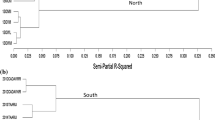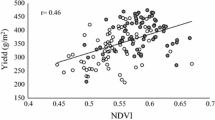Summary
Heading time and its constituent traits, photoperiodic response, narrow-sense earliness and vernalization requirement, were surveyed for 158 wheat landraces. Wide varietal variation was observed in each character. Nearly half of the variation for each character was explained by a geographical difference in origin. Based on these data and the growing environments in each locality, we analyzed “adaptation strategy”, seen as the adjustment of heading time in terms of differences in the constituent traits, both individually and combined. The difference among localities indicated that wheat landraces had been selected for early heading as an adaptation strategy to water stress and/or high temperature in early summer. This change was caused by a reduction in photoperiodic response and narrow-sense earliness. The vernalization requirement was also reduced for adaptation to relatively mild winters. Adaptation strategy deduced from the variation within each locality was also different amongst localities. In the central region of wheat evolution, where wide variations existed in both photoperiodic response and narrow-sense earliness, the late-heading trait was achieved by either one of these traits individually or both of them combined. On the contrary, in the eastern and the western regions, wide variation in heading time was achieved by the unique combination of photoperiodic response and narrowsense earliness. A sampling strategy for wheat germ plasm is also discussed.
Similar content being viewed by others
References
Bekele E (1984) Analysis of regional patterns of phenotypic diversity in the Ethiopian tetraploid and hexaploid wheats. Hereditas 100:131–154
Ehdaie B, Waines JG (1989) Genetic variation, heritability and path-analysis in landraces of bread wheat from southwestern Iran. Euphytica 41:183–190
Fischer RA, Maurer R (1978) Drought resistance in spring wheat cultivars. I. Grain yield responses. Aust J Agric Res 29:897–912
Gotoh T (1976) Studies on varietal differences in vernalization requirement in wheat. Jpn J Breed 26:307–327. (in Japanese)
Hatakeyama H (1964) Climate in Asia. Kokin Shoin, Tokyo, (in Japanese)
Hoogendoorn J (1985) The physiology of variation in the time of ear emergence among wheat varieties from different regions of the world. Euphytica 34:559–571
Jaradat AA (1991) Levels of phenotypic variation for developmental traits in landraces genotypes of durum wheat from Jordan. Euphytica 51:265–271
Kato K, Yamagata H (1988) Evaluation of chilling requirement and narrow-sense earliness of wheat cultivars. Jpn J Breed 38:172–186
Kato K, Yamashita S (1991) Varietal variation, photoperiodic response, chilling requirement, and narrow-sense earliness and their relation to heading time in wheat (Triticum aestivum L.). Jpn J Breed 41:475–484
Kato K, Wada T, Hayashi K (1989) Varietal difference in narrow-sense earliness of wheat and the genetic analysis. Jpn J Breed 39 [Suppl 1]:406–407. (in Japanese)
Keim DL, Welsh JR, McConnell RL (1973) Inheritance of photoperiodic heading response in winter and spring cultivars of bread wheat. Can J Plant Sci 53:247–250
Kramer PJ (1980) Drought, stress, and the origin of adaptations. In: Turner NC, Kramer PJ (eds) Adaptation of plants to water and high temperature stress. John Wiley & Sons, New York, pp 7–20
Marcellos H, Single WV (1984) Frost injury in wheat ears after ear emergence. Aust J Plant Physiol 11:7–15
Murphy PJ, Witcombe JR (1981) Variation in Himalayan barley and the concept of centres of diversity. In: Asher MJC, Ellis RP, Hayter AM, Whitehouse RNH (eds) Barley Genetics IV. Edinburgh University Press, Edinburgh, pp 26–36
Perrin de Brichambaut G, Wallen CC (1963) A study of agroclimatology in semi-arid and arid zones of the Near East. WMO Technical Note No. 56, WMO Publication
Pugsley AT (1972) Additional genes inhibiting winter habit in wheat. Euphytica 21:547–552
Qian CM, Xu A, Liang GH (1986) Effects of low temperatures and genotypes on pollen development in wheat. Crop Sci 26:43–46
Qualset CO, Puri YP (1974) Heading time in the world collection of durum wheat: Photo- and thermal-sensitivity related to latitudinal responses and geographic origins. In: Proc Int Symp Genet Breed Durum Wheat. Bari, pp 165–78
Saini HS, Aspinall D (1982) Abnormal sporogenesis in wheat (Triticum aestivum L.) induced by short periods of high temperature. Ann Bot 49:835–846
Sofield I, Evans L, Cook MG, Wardlaw IF (1977) Factors influencing the rate and duration of grain filling in wheat. Aust J Plant Physiol 4:785–797
Tanaka M (1983) Catalogue of Aegilops-Triticum germ plasm preserved in Kyoto University. Kyoto University, Kyoto
Witcombe JR, Rao AR (1976) The genecology of wheat in a Nepalese centre of diversity. J Appl Ecol 13:915–924
Worland AJ, Petrovic S, Law CN (1988) Genetic analysis of chromosome 2D of wheat. II. The importance of this chromosome to Yugoslavian varieties. Plant Breed 100:247–259
Yoshida H, Kamio M, Kawaguchi K (1983) Evaluation of cultivars for early matureness in the Japanese wheat breeding. In: Sakamoto S (ed) Proc 6th Int Wheat Genet Symp. Maruzen, Kyoto, pp 601–612
Author information
Authors and Affiliations
Additional information
Communicated by J. W. Snape
Rights and permissions
About this article
Cite this article
Kato, K., Yokoyama, H. Geographical variation in heading characters among wheat landraces, Triticum aestivum L., and its implication for their adaptability. Theoret. Appl. Genetics 84, 259–265 (1992). https://doi.org/10.1007/BF00229480
Received:
Accepted:
Issue Date:
DOI: https://doi.org/10.1007/BF00229480




